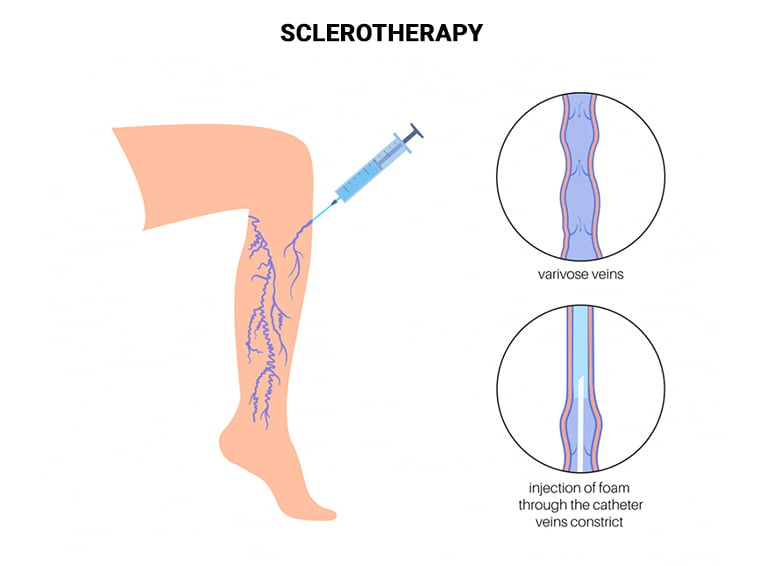
If your leg skin is changing color and developing a reddish-brown tinge, do not take it lightly and seek medical attention as it might be a sign of vein disorder. Discoloration of the lower legs is mainly caused by hemosiderin that indicates red blood cells are leaking through the veins, extending to further complications. Dr. George Bolotin at the Astra Vein Treatment Center will examine your legs carefully to make an accurate diagnosis and help you understand why your legs are turning brown and how they can be treated successfully.
Hemosiderin staining occurs when red blood cells leak through the veins. As iron and other by-products are released from the veins, they show a brown stain on the skin. Brownish discoloration or bruising on the lower legs can result from poor vein health or problems with the functioning of blood vessels called chronic venous insufficiency.
Our skin also undergoes a lot of change as we age. It can thin, and dry out and lose its elasticity. In some cases, it loses color and texture on the knees, legs, and ankles and turns a dark tinge. Long-term or painful discoloration and staining are a cause for concern. They affect the appearance of the legs and lead to complications if left untreated for a long time.
Get your symptoms carefully checked by an experienced doctor to ensure they are not a sign of some life-threatening medical disorder.
Hemosiderin staining could happen for several reasons.
Chronic vein disease
Chronic vein disease is the primary cause of hemosiderin staining. The reddish-brown discoloration indicates abnormal functioning of veins. It mainly occurs when the veins in the lower extremities, like legs and feet, cannot pump blood back up to the heart, and it begins to pool in the legs.
Vein diseases take time to manifest. Starting from mild, the symptoms can become painful if they are not cared for timely. It is possible to control chronic vein disease with early detection, and lifestyle changes also help to fix the condition.
Symptoms of chronic vein disease include:
Other vein disease symptoms that cause brown staining on the legs include:
As blood continues to pool in the veins, its cells break down and leak iron pigmentations into the skin, and it shows up as brown patches or stains on the lower legs or ankle with time. If it is left untreated, the stain patches can darken and even turn black.
When red blood cells break down, hemoglobin is stored as hemosiderin. The white blood cells, or immune system cells, can clear up some of the excess iron released into your skin, but some medical conditions can affect this process. It results in staining on the legs and feet.
Common conditions associated with hemosiderin staining include:
If your hemosiderin staining is a side effect of some injury or other treatment, it will clear up on its own. Staining due to heart and vein disease and chronic wounds often persists, but the pigmentation can lighten over time with medical advice.
Hemosiderin staining is more than a cosmetic issue. The pigmentation itself is not a problem, but the conditions that cause the discoloration can be severe and need careful investigation by a vein expert doctor. The skin changes indicate poor blood circulation that triggers chronic pain and other medical complications like leg ulcers and skin infections.

Sclerotherapy is a popular treatment option for vein disease and varicose veins. During this procedure, a chemical substance known as a sclerosant is injected into the affected veins to reduce the vein size or closes them shut.
In some cases, sclerotherapy side effects cause hemosiderin staining as a result of iron deposits. This discoloration is often temporary and disappears in a couple of weeks, but these stains are permanent for some people.
If you are going for sclerotherapy, there are a few factors that you must keep in mind regarding its side effects. They include:
Treating hemosiderin staining is not only about getting rid of the discoloration on the legs but the vein disease that is causing this condition. Visit an expert vein doctor who will determine the severity of the problem and causes behind your symptoms to find the best solution to cure them.
Your doctor may recommend the following treatments to lighten the dark spots on the skin. They include:
Effects of hemosiderin staining can fade away with timely treatment, but in some cases, it may be impossible to get rid of discoloration even after treatment.
Hemosiderin staining of the skin due to an underlying medical condition can only be treated with proper diagnosis and management of the symptoms. Schedule an appointment with an experienced vein doctor to discover and address the root causes, including diabetes, blood vessel disease, or high blood pressure.
Brownish or bruised skin on the knees, lower legs, or ankles could be an early sign of vein disease, especially when accompanied by achy, heavy, and swollen legs. Timely detection and treatment of vein disease can lighten the brown stains and even prevent them from getting darker. Hemosiderin staining treatment reroutes the blood to healthier veins and closes or scars the unwanted veins to avoid pain and discoloration.
Treating vein diseases is crucial for avoiding further complications and ensuring overall good health, as blood circulation problems resulting from venous reflux could be critical if left untreated.
At the Astra Vein Treatment Center, Dr. George Bolotin will help you with hemosiderin staining and determine its root causes most successfully to target your specific symptoms. Relying on advanced diagnostic equipment and a multidisciplinary approach to know more about your vein conditions, the vein specialist will combine the most effective treatment options to improve your quality of life.
Vein & Vascular Medical Care
4209 Ave U, Suite A.
Brooklyn, NY 11234
(347) 934-9068
Vein & Vascular Medical Care
869 E Tremont Ave
Bronx, NY 10460
(929) 447-4563